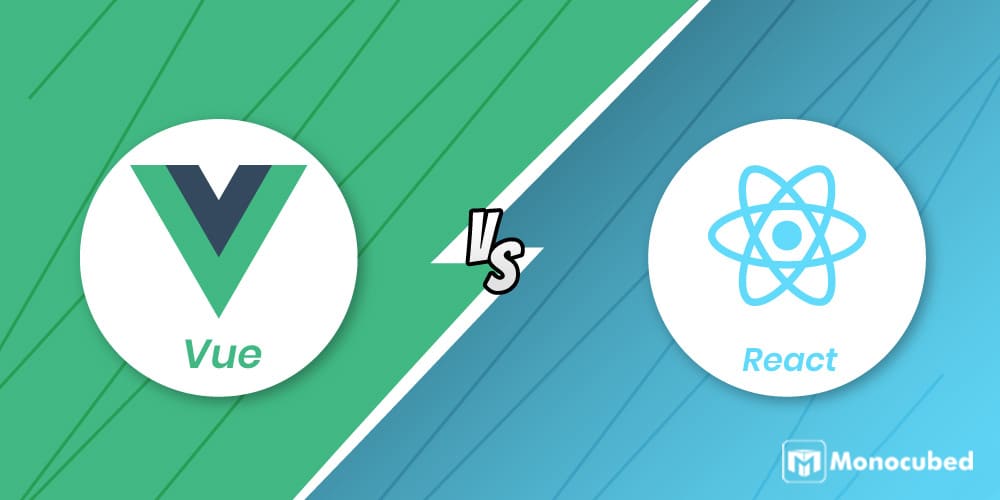React.js and Vue.js are the two frontend JavaScript frameworks that are popular in the developer world. React works together with HTML documents through virtual DOM and is abided by a declarative form of programming.
On the contrary, Vue is seen as a progressive framework that states that you can migrate your current projects’ features at a given time.
Both React and Vue offer software developers a constructive approach to building varied web applications, but each has its best usage cases and responds to different business needs.
In this article on Vue vs React, we will explore its concepts and what makes these two technologies unique.
As a web development agency, we let our experienced web developer explain the difference between React and Vue. Let’s start with understanding what exactly is Vue?
Table of Content
What is Vue.js?
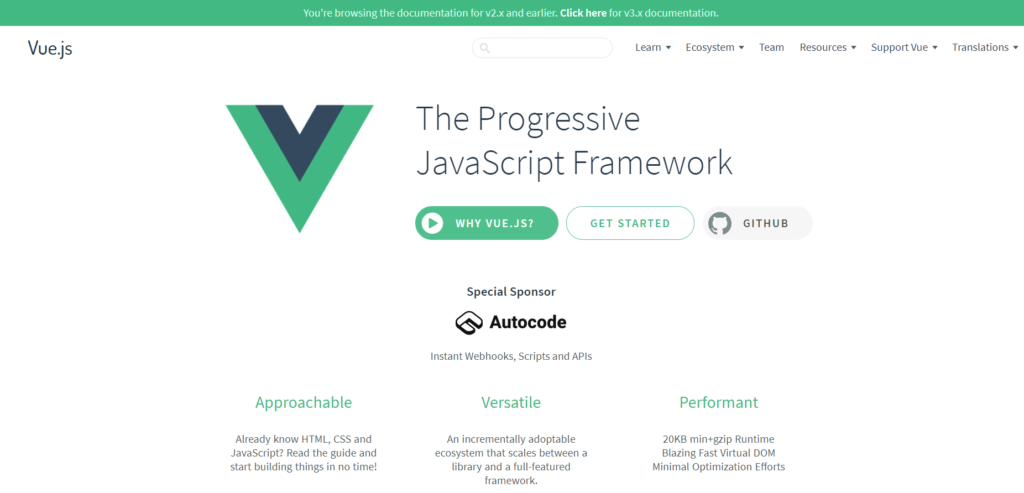
Vue.js is a front-end and open-source JavaScript framework. Its model-view-view-model architecture is used for developing single-page applications, progressive web app, and user interfaces.
It is developed by Evan You and employs ‘high decoupling’, permitting the Vue developers to gradually make user interfaces.
Vue.js is an advanced framework for developing user interfaces. Contrary to the rest of the monolithic frameworks, Vue js is created from scratch to be incrementally adoptable.
The main library of the Vue framework is dedicated to the view layer only and is pretty easy to pick up as well as incorporated with many libraries or prevailing projects.
Moreover, Vue js is also impeccably proficient in powering classy single-page applications when utilized in an arrangement with supporting libraries and contemporary tooling.
Features of Vue.js
Vue.js is one of the most renowned web frameworks that is used to streamline web app development.
Vue js can be easily assimilated into huge projects for front-end app development without any problems.
Progressive features essential to build complex apps, such as state management, routing, and build tooling are presented via Vue js libraries and packages. Nuxt.js is one of the best solutions for Vue developers.
Below are some of the vital features presented:
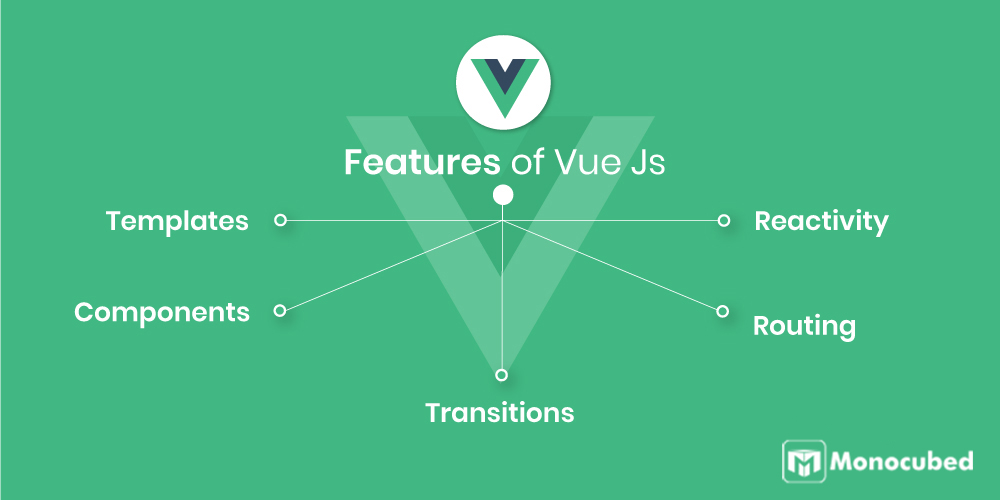
-
Templates
Vue utilizes HTML-oriented template syntax that permits binding the concentrated Document Object Model (DOM) to the fundamental Vue occurrence’s data.
All the Vue templates are effective HTML that can be described by HTML parsers and specification-compliant browsers. Vue accumulates the templates into a virtual object that is a duplicate of the original browser DOM.
Adapted from React’s functioning, a virtual DOM allows Vue js developers to perform actions on the components in its memory before updating the web browser.
United with the reactivity scheme, Vue is capable to compute the marginal number of components to re-deliver and apply the nominal amount of DOM manipulations when the state of the app changes.
The users can employ template syntax or opt to directly compose render functions utilizing JSX.
These render functions permit the Vue applications to be developed from software components.
-
Components
Vue.js components prolong elementary HTML elements to compress reusable code. At a great level, the components are customized elements to which Vue compiler affixes the behaviour.
In Vue, the component is basically a Vue example with pre-defined alternatives.
-
Transitions
Vue offers a diversity of ways to implement transition effects when the items are updated, inserted, or removed from DOM. This comprises tools to:
- Exercise JavaScript to straight away manipulate DOM during the transition hooks
- Assimilate the third-party JavaScript animation library, namely, Velocity.js
- Mechanically apply the classes for CSS animations and transitions
- Incorporate the third-party CSS animation library, namely, Animate.css
-
Routing
Vue employs the official Router to route users through URLs.
The most common shortcoming of single-page applications (SPA) is the inability to segment links to the precise subpage within a definite web page.
As SPA serves the users only one URL-oriented reply from the server, bookmarking some screens or allocating the links to explicit sections is generally tough, if not unmanageable.
To decipher this issue, numerous client-side routers restrict their dynamic URL with a ‘hashbang’ (#!).
-
Reactivity
Vue presents a reactivity structure that exercises plain JavaScript objects and augmented re-rendering.
Every Vue component keeps a track of its responsive dependencies during its rendering, so the structure knows exactly when to re-render, and which components to re-render.
Have a Web App Idea?
Get your idea validated from professionals for free. Consult about technologies to use and features to add. Start designing.
What is React?
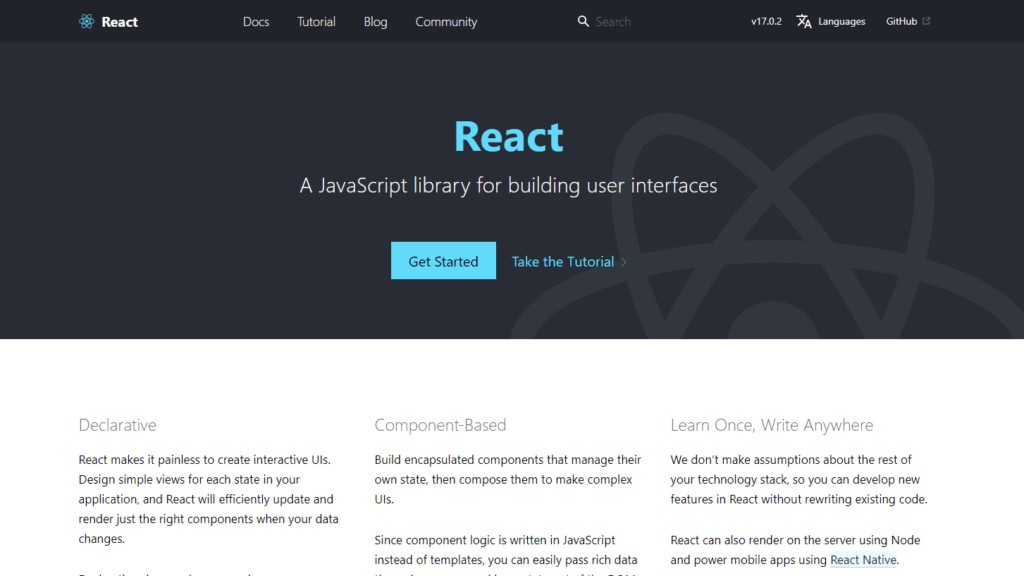
React is a front-end, open-source JavaScript library used for developing user interfaces or UI components.
It is conserved by Facebook and a group of distinct companies and experienced React developers. React can be utilized as a base in mobile apps or single-page application development.
Just like Vue, React js follows a component based architecture. Nevertheless, React is only concerned with delivering the data to DOM.
So forming React applications generally necessitates the usage of additional libraries for routing and state management. React Router and Redux are examples of these libraries.
React employs a declarative pattern that forms it easier to reason about the application and targets to be both flexible and efficient.
It schemes simple views for every state in the application and React will competently update and deliver just an apt component when the data alters.
The declarative view makes the code more anticipated and simpler to debug for React developers.
Features of React
React apps are composed of manifold components, each accountable for offering a trivial, reusable part of HTML.
The components can be amalgamated within several other components to permit complex applications to be developed out of uncomplicated building blocks.
At present, React.js is achieving rapid popularity as the best JavaScript framework amongst web developers. It is playing a vital role in the front-end environment.
The significant features of React.js are as follows:
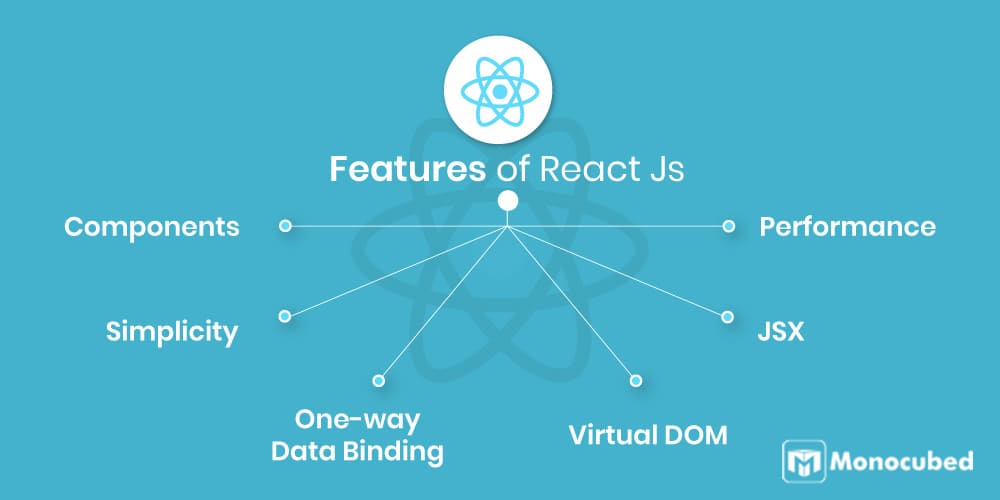
-
Components
React is about the components. React.js applications are composed of manifold components, and every component has its controls and logic.
Such components can be reused which aid you to conserve the coding when functioning on large scale projects.
-
One-way Data Binding
React js is fabricated in such a way that monitors one-way data binding or unidirectional data streams.
The advantages of one-way data binding supply you with improved control throughout the web application. If the data flows only one way, the developer has a single source of information.
Any changes he makes are done at a fixed place and all the other React components will inherit the changes.
If the data movement is in a different direction, then it needs additional traits. There can be conflicting data values in a single app, which is a problem many Vue js developers face.
It is because the components are invented to be irreversible and the data inside them cannot be altered.
React Flux is a design that assists to keep the data unidirectional. This forms the web application to be more flexible and it leads to increased efficiency.
-
Virtual DOM
A virtual DOM object is the depiction of an inventive DOM object. It functions as a one-way data binding in React.
When any amendments occur in the application, the complete UI is re-rendered in a virtual DOM depiction. Then it examines the difference between the former DOM depiction and the new DOM.
Once it has been completed, the actual DOM will update the things that have been transformed.
This makes React apps quicker, and there is no depletion of memory.
-
JSX
JavaScript XML (JSX) is a JavaScript syntax extension. It is an HTML or XML like syntax utilized by React.js.
The syntax is administered well into JavaScript calls of React framework. It encompasses ES6 so that the HTML-like text can be present with JavaScript react coding.
It is not essential to utilize JSX, but it is suggested to employ it in React.js.
-
Performance
React.js is recognized to be an excellent performer. This characteristic makes it better than the rest of the web frameworks available today.
The motive behind this is that it administers the virtual DOM. The DOM is a cross-platform and programming API that transacts with XML, XHTML, or HTML.
The DOM occurs completely in memory. Owing to this, when we form a component, we did not write straight away to DOM. In its place, we write the virtual components that will turn DOM leading to faster and smoother performance.
-
Simplicity
React.js employs the JSX file which makes the web application easy to code and understand.
We know that React.js has a component-oriented method that forms the code reusable as per your requirement. This creates it simple to learn and use.
Vue vs React: The Vital Differences
Vue and React are two web frameworks that are dedicated to making the life of developers easier. They speed up the procedure of turning a notion for an online project into reality.
By default, Vue utilizes HTML templates, but there is an alternative to transcribing in JSX. On the other hand, React solely uses JSX.
The following table depicts the noteworthy difference between Vue and React:
| Attributes | Vue | React |
|---|---|---|
| Technology | Vue.js framework is built for UI development and design. The primary functionality is aimed at interface-related errands. | React is a JavaScript library and framework for UI development. The React ecosystem permits the tools to be accountable for complex data processing, UI processes, and personalization. |
| Invention | Vue is developed by Evan You. | React is developed and supported by Facebook. |
| Performance | Vue utilizes virtual DOM and operational principles that are similar to React. However, Vue is more rapid when it comes to building UI components. | React employs a virtual DOM – an object model that does not depend on a web browser. The framework mechanically delivers HTML pages. |
| Mobile Development | Vue supports Weex – a mobile UI framework built by Alibaba Group. The framework utilizes Vue components to develop Android and iOS applications and sanctions reusing web code. | React offers React Native, official component library for building iOS and Android native apps with the same React component construction. |
| Size | The size of the Vue is about 20KB min+gzip. | The size of the React is about 100KB. |
| When to Use | Vue js can be used to build small web page apps that are intended to be lightweight and fast. | React js can be used to build community-based platforms. Eg: marketplace and forum. |
| Platforms | It can be employed in content delivery platforms as it is fast and functions well in low-latency. | It can be employed in multifaceted platforms with rich mobile and web functionality. |
| Scaling | Vue offers scaling projects with advanced performance speed. | React offers an improved ecosystem, additional templates, and more tools. |
Advantages and Disadvantages of Vue
Advantages of Vue
From the above table on Vue js vs React, we can gauge that there are some benefits of utilizing Vue js, which must inspire developers to employ it in the projects.
For example, Vue js is similar to Angular in various aspects such as two-way data binding, and it endures to relish its growing popularity as compared to other frameworks available in the market.
-
Readability
Programmers that are acquainted with other JavaScript frameworks can select Vue easily due to its = clarity and simplicity. Vue syntax is easy and simple to comprehend.
Skilled developers that begin functioning with Vue find its construction very instinctive as Vue components are much a combination of JavaScript and HTML.
Owing to its simple construction, it allows the web development of large-scale templates and developers can still track the blocks with errors if any.
-
Size
One of the greatest benefits of employing Vue js is its size as you can get a readymade project that weighs just 20KB. The size is invincible with all the other frameworks like React.js, Angular, and jQuery.
-
Documentation
Vue.js has detailed and extensive documentation which makes it quick and easy to learn. It permits an inexperienced developer, having a basic knowledge of JavaScript and HTML, to build an app.
This states that even a beginner can manage complex operations utilizing only inadequate resources and it would still function well.
-
Easy Development
When you build an application, the error is obvious to happen. Nevertheless, what matters the most is how effortlessly you find the errors and fix them. Vue.js does the same.
It has a simple construction that aids developers from small to huge-scale templates and catches the blocks containing errors.
You can also save much of your time while building the templates.
-
Versatility and Scalability
Dissimilar to other frameworks, Vue js can be utilized as a library and a rich framework. Why individuals love to go with Vue js is due to its scalability.
It can be changed, modified, and scale up as per your needs. Also, if you need to make any integration or require to build an application, it can consume the REST API.
Disadvantages of Vue
-
More Flexible than Required
Flexibility is outstanding, but it is not always good as when you are functioning on some substantial projects in which the developers are involved, then it will form some problems.
Over-flexibility is the reason for more irregularity and errors within the coding. Such a loophole states that projects will get postponed.
-
Fewer Components or Plugins
Common plugins are beneficial as they function with several other tools to make the development simple. Vue js does not possess most of the general plugins, and that is the disadvantage of Vue.js.
-
Issues with Safari and iOS
If you are utilizing the Vue js app on older versions of Safari and iOS, then you are likely to face some problems, though they are manageable.
-
Small Community Support
Vue was originally developed in 2014, and hence it is still new and developing very fast.
As a consequence, it is not so prevalent as compared to the rest of the frameworks like Angular and React.
Moreover, as a Chinese company has formed the framework, most of the codes have been transcribed in the Chinese language, which generates certain issues for English-speaking users of Vue.
Contrary to the React community, which is thriving, the Vue community does not yet enjoy such massive support. This could be because most of the community members are non-English speakers that too in small numbers.
Advantages and Disadvantages of React
Advantages of React
-
Producing Dynamic Web Apps
To build a dynamic web application explicitly with HTML strings was complicated because it required multifaceted coding, but React.js resolved that problem and made it easier.
It offers less coding and renders more functionality.
It makes use of the JavaScript extension, which is a specific syntax letting HTML tag syntax and HTML quotes to offer precise subcomponents. Also, it supports the development of machine-readable code.
-
Easy to Use
React.js is very easy to learn and employ. It gives a good supply of tutorials, documentation, and training resources.
Any developer who knows JavaScript background can effortlessly understand and begin building apps utilizing React in just a few days.
-
Support of Handy Tools
React.js has also attained popularity due to the availability of a handy collection of tools. Such tools make the chores of developers easier and understandable.
React developer tools have been fabricated as Firefox and Chrome dev extensions and permit you to examine React component hierarchies in virtual DOM.
It also permits you to choose precise components and scrutinize and edit the existing state.
-
SEO Friendly
The classic JS frameworks have trouble in dealing with SEO. The search engines usually have issues in reading JavaScript-loaded applications.
Many developers have often criticized this issue. React.js overcomes such a problem that aids developers to get easily directed on numerous search engines.
It is for this reason that React.js apps can function on the server, and virtual DOM will be delivered and returned to the browser as a normal web page.
Want to Grab Your User’s Attention?
Talk to us and develop a rich, attractive UI-UX design using React that grabs your user’s attention. Let’s start designing.
Disadvantages of React
-
Poor Documentation
React.js technologies are accelerating and updating so rapidly that there is no sufficient time to make any proper documentation.
To overcome this issue, web developers write commands on their own with the evolving of new tools and releases in their existing projects.
-
Incompleteness
React facilitates only the View portion of the MVC model. Owing to that, you will have to depend on some other technologies also.
However, the developers observe it as a benefit as it permits complete independence. And because of that, each project might appear different.
-
High speed of development
The high speed of development has benefits and drawbacks. In the case of drawbacks, since the ecosystem continually alters so fast, some developers do not feel comfortable learning again the novel ways of doing things regularly.
It may be difficult for them to accept these changes with all the unceasing updates. They have to upgrade their skills and study new ways of doing tasks.
Frequently Asked Questions
Which is better – Vue or React?
In comparison between React and Vue frameworks, the former delivers more flexibility and is as stable as the latter. But Vue is more organized and easier to set up which results in reduced project duration. React documentation is good, but Vue documentation is mostly considered better. Also, Vue is simpler to learn as compared to React.js.
Angular vs React vs Vue – Which one is best?
Vue offers advanced customizability and henceforth it is easier to learn than Angular or React. Furthermore, Vue js has an overlap with React and Angular by their functionality like usage of the components. Therefore, the evolution of Vue from either of the two is an easy alternative.
Will Vue takes over and React?
Vue is relatively a new framework, and it will take much time to touch the scale of the React environment. Though both the frameworks have their own set of advantages and disadvantages, React is certainly the best framework that you can opt for the next development project.
Conclusion
React and Vue both are great tools for developing an interactive user interface.
To select which one is apt for your project, you have to take several factors into account, comprising your business needs, specific use case, developer availability, environment, timeframe, and budget.
From the above discussion on React vs Vue, if we talk about performance, Vue is on par with React.js. On the other hand, React.js is great for developing complex enterprise applications.
Contact Monocubed, if you have a web app in mind and require experienced developers to understand your project and develop using React or Vue.
 By Yuvrajsinh Vaghela
By Yuvrajsinh Vaghela
